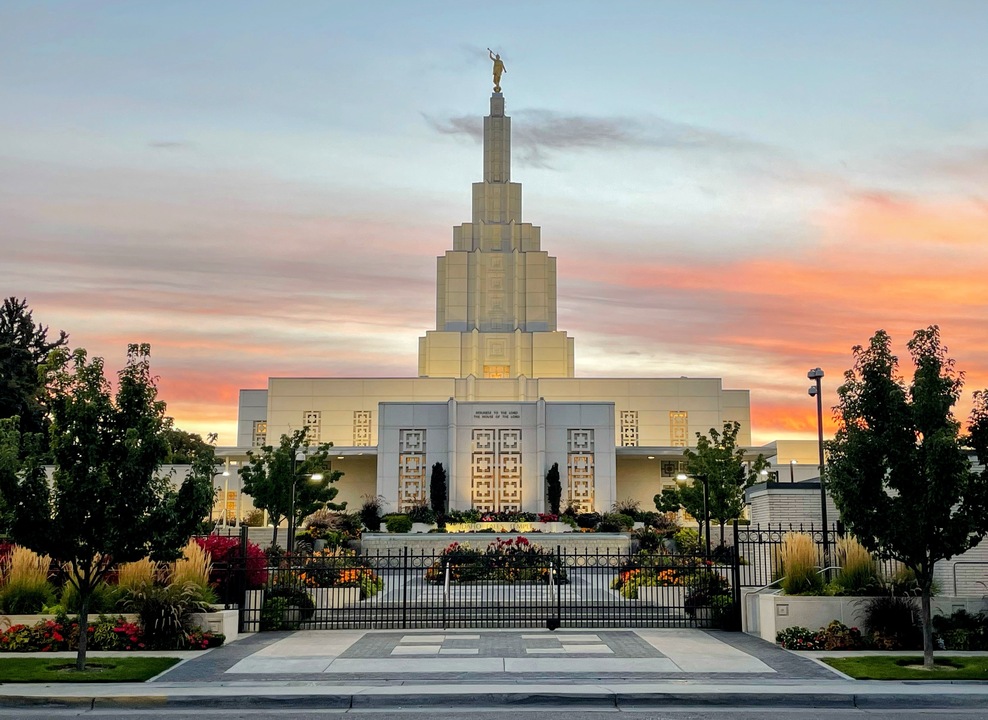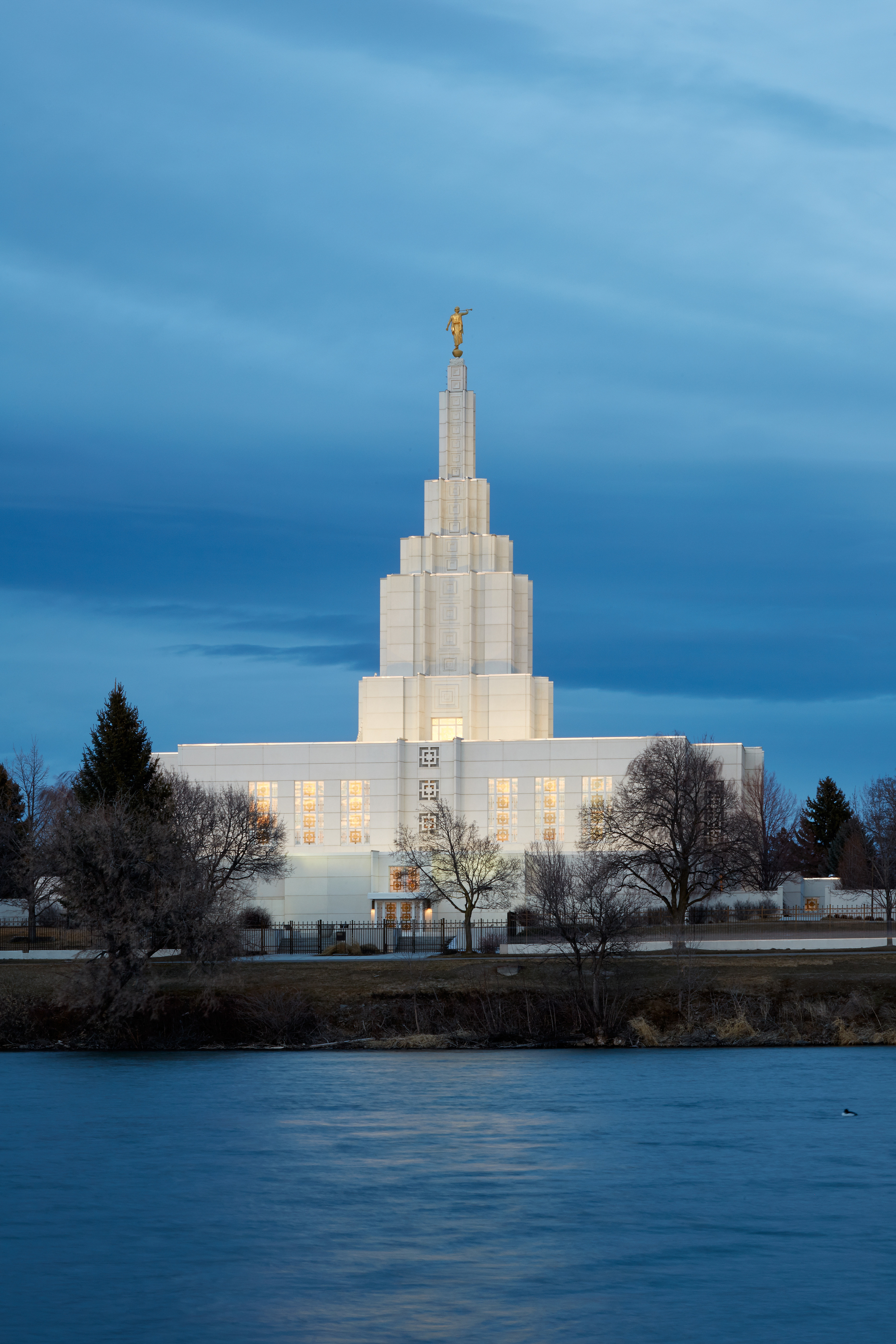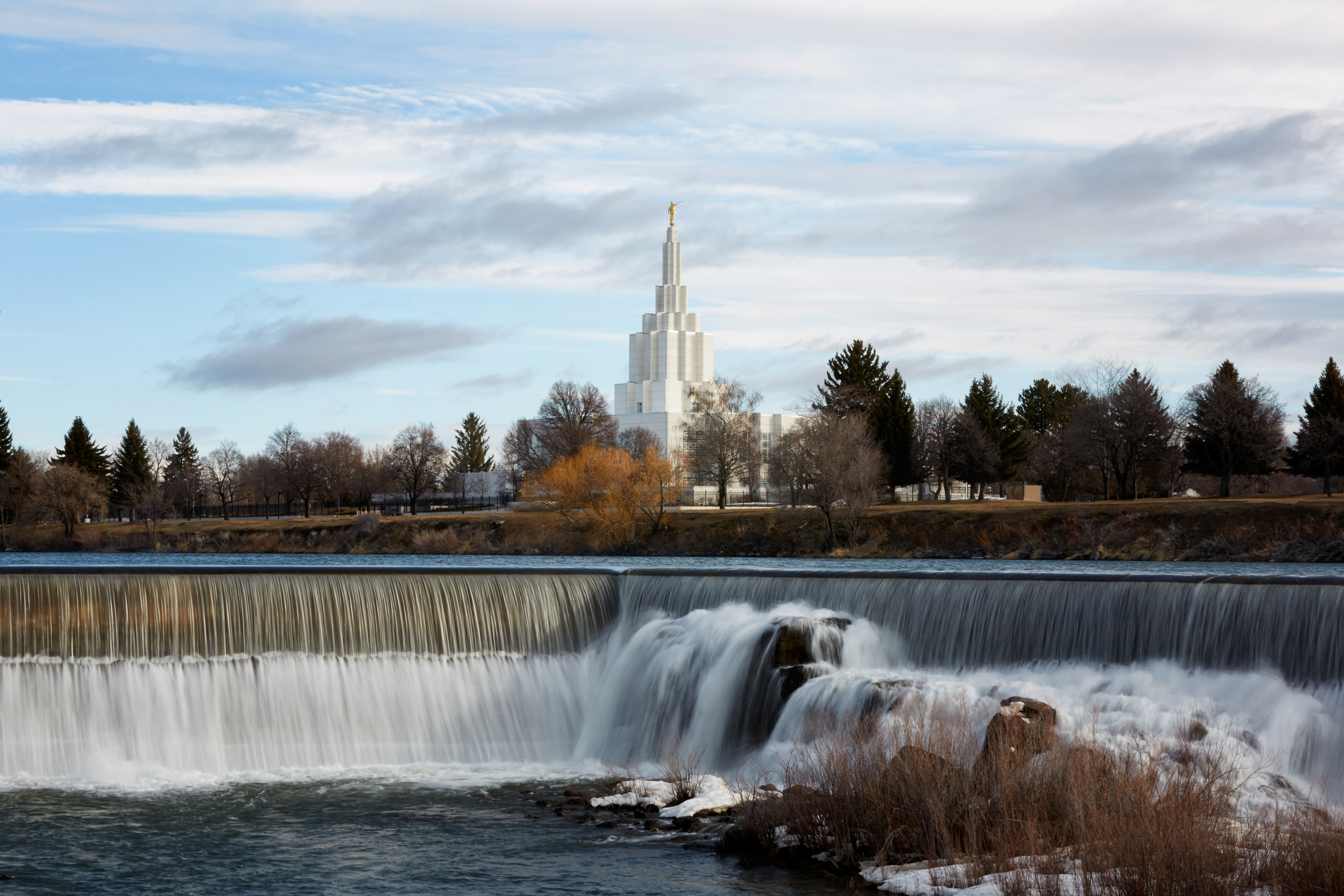The Idaho Falls Temple, a significant structure, holds a special spot in the heart of its community. It stands by the Snake River, a gleaming white building that truly acts as a central piece for the city. This particular building went through a big refresh, a renovation, in 2017, making it feel renewed and ready for many more years of service. You can also visit a public visitors' center nearby, and there's a pretty waterfall feature that draws people in, too.
This striking building, you know, has a rich story behind it, reaching back many years. It was, in fact, the very first temple to be put up in the state of Idaho. Its presence is deeply tied to the prominent waterfall close by, which, in a way, lends its name to the temple itself. There are, actually, twelve new pictures available now that show off this beautiful structure, capturing its look from different angles.
For those curious about its history or its features, there's quite a bit to explore. You can find out about its exterior and interior design, how it was remodeled, and the details of its rededication. There are also facts and images that help tell the full story of this building's journey, from its early beginnings to its current role in the community. It’s a place that, in some respects, invites people to learn more about its purpose and its place.
- Beau Jos
- Siff Cinema Downtown
- Pine Creek High School
- University Of Michigan Museum Of Natural History
- Mt Playmore
Table of Contents
- A Beacon by the Water - The Idaho Falls Temple's Place
- What Makes the Idaho Falls Temple Stand Out?
- A Look at the Idaho Falls Temple's Design and Upkeep
- How Has the Idaho Falls Temple Changed Over Time?
- Serving the Community - The Idaho Falls Temple's Reach
- Who Benefits from the Idaho Falls Temple's Presence?
- The Idaho Falls Temple and Its Surroundings
- What Unique Architectural Features Does the Idaho Falls Temple Possess?
A Beacon by the Water - The Idaho Falls Temple's Place
Standing right alongside the Snake River, the Idaho Falls Temple presents itself as a bright, shining white building. It is, quite literally, a central point, a centerpiece for the city of Idaho Falls. This building has a very strong visual presence, drawing the eye and giving the city a distinct character. It’s a place that, in a way, seems to watch over the community, offering a sense of stability and enduring purpose. The way it looks, clean and bright, makes it a truly noticeable landmark for anyone in the area, or those just passing through, you know.
The land where this building stands was a gift, a donation, from the Idaho Falls Chamber of Commerce. This act of giving helped make the construction of the temple possible, providing the physical space needed for such a significant structure. It shows, in some respects, a cooperative spirit within the community, where local groups contributed to the creation of something that would serve many people. The decision to place it by the river was, perhaps, a thoughtful one, creating a very pleasing visual setting for the building itself. It feels like it was meant to be there, actually, right by the water.
This particular temple holds the distinction of being the first of its kind to be put up in the state of Idaho. That's a pretty big deal, really, marking it as a pioneer among such buildings in the region. Its location is also quite special, sitting very close to a well-known waterfall feature. This natural wonder is so prominent that, quite simply, the temple takes its name from it. So, the name itself connects the building directly to the natural beauty of its surroundings, which is a nice touch, too.
- Doubletree New Orleans
- Costco New Orleans
- Barry Goldwater High School
- Colorado Springs Airport Colorado Springs Co
- Embassy Suites Fll 17th
What Makes the Idaho Falls Temple Stand Out?
One of the things that makes the Idaho Falls Temple quite special is its original construction material. It was built using reinforced concrete, a sturdy material that gives the building its solid form. The actual dedication of the temple, marking its completion and readiness, happened in October of 1940. This date is a key part of its history, showing when it first became a fully functional place. Yet, there was another dedication event, later on, in 1945, which was performed by George Albert Smith. This suggests, perhaps, different stages of its official opening or recognition, which is interesting to consider, you know.
The announcement that this temple would be built, the Idaho Falls Idaho Temple specifically, came on March 3, 1937. That date marks the very beginning of its public story, the moment when the idea started to become a reality. As the building work started, leaders from the Church of Jesus Christ approached a company that made cement products. This company was located in Salt Lake City, Utah. The church leaders asked if this company could provide the specific materials needed for putting up the Idaho Falls Idaho Temple. This shows, in a way, the practical steps taken to bring the building to life, reaching out to those who could supply the very foundations of the structure, so.
The Idaho Falls Idaho Temple is one of only seven temples that have a particular design for how people move through them. In these specific temples, people go through four distinct ordinance rooms before they enter what's called the celestial room. This progression is a unique architectural and functional feature. The other six temples that share this characteristic are the Manti Utah Temple, the Salt Lake Temple, the Laie Hawaii Temple, the Cardston Alberta Temple, the Los Angeles California Temple, and the Nauvoo Illinois Temple. This shared design makes the Idaho Falls Temple part of a rather select group, which is pretty neat, actually.
A Look at the Idaho Falls Temple's Design and Upkeep
The building, the Idaho Falls Temple, received a significant refresh in 2017. This renovation project was a big undertaking, bringing the structure up to date and ensuring its continued good condition. It means that the temple, while having a long history, also has a very current and cared-for feel to it. This kind of work is, you know, essential for maintaining such an important building over many years, keeping it looking its best and functioning properly for everyone who uses it. It shows a real commitment to its preservation, too.
When you look at the temple, you can see pictures, facts, and specific details about its outside appearance, its exterior design, and its inside spaces, the interior design. You can also learn about the remodel work that was done and the rededication event that followed. These details help tell the story of how the building has been cared for and adapted over time. It gives you a complete picture, really, of its physical form and how it has been maintained through different periods. There's a lot to take in about its look and feel, both inside and out, so.
The temple itself was put together using reinforced concrete, a material chosen for its strength and lasting quality. This choice of building material speaks to the desire for the temple to stand for a very long time, enduring through the years. It was, as mentioned, dedicated in October of 1940, marking the completion of its initial construction. This early dedication date is a key part of its timeline, establishing its foundational history. The choice of materials and the original construction date both point to a building that was made to last, you know, to be a permanent fixture.
How Has the Idaho Falls Temple Changed Over Time?
The temple had a dedication ceremony in 1945, with George Albert Smith presiding over the event. This specific dedication marked an important moment in its early history. Later on, in 2017, the temple went through a big renovation. This update brought changes and improvements to the building, making it more current and functional. So, you have these two key dates, 1945 and 2017, that really highlight significant points in the temple's existence, showing both its initial purpose and its ongoing care, you know, over the years.
This particular temple has a unique design feature: it contains four ordinance rooms and seven sealing rooms. These specific numbers and types of rooms are part of its functional layout, serving the purposes for which the temple was built. The fact that it has these distinct spaces means it was designed with particular activities in mind. The arrangement of these rooms helps define how the building is used and what goes on inside its walls. It's a very specific kind of internal arrangement, too, that makes it what it is.
The Idaho Falls Temple holds a special place in history because it was the last temple that was truly built for what's called a "live endowment" presentation. This means the way the services were conducted originally involved people speaking and acting them out in person. While the Los Angeles Temple also had all four rooms for this purpose, it started using a tape recording for its presentations right from its dedication. The Idaho Falls Temple, even though it now uses film to present the endowment, still keeps its unique architecture. This unique design, in a way, stands as a reminder of its original purpose and how it was first used, which is pretty interesting, actually.
Serving the Community - The Idaho Falls Temple's Reach
Following its rededication, the Idaho Falls Temple is set to serve a significant number of church members. It will provide a place of worship and service for members from 45 stakes. These stakes are located in southeastern and central Idaho, covering a wide geographic area. This means the temple plays a very important role for a large group of people across a considerable part of the state. Its purpose, you know, is to be a central point for many different communities, offering a shared place for their activities and spiritual practices.
The temple, being a central point for so many, also means that many people will be involved in its operation and care. The text mentions a list of 79 couples who will begin serving as temple presidents and matrons around the world this year. While this specific list isn't directly tied to the Idaho Falls Temple's operations alone, it speaks to the broader system of temple service. It shows, in a way, the dedication of many individuals who give their time to these important buildings. It’s a reminder that temples, like the Idaho Falls Temple, rely on the service of many people, which is pretty significant, too.
The very ground the temple stands on was a generous gift. The land was donated by the Idaho Falls Chamber of Commerce. This act of giving highlights a connection between the temple and the local community, showing how civic organizations contributed to its establishment. It means the physical space itself has roots in community support and cooperation. This kind of local backing is, you know, a foundational part of the temple's story, allowing it to become a part of the city's fabric from the very beginning, so.
Who Benefits from the Idaho Falls Temple's Presence?
The presence of the Idaho Falls Temple brings benefits to a wide array of people, especially those who are members of the church in the surrounding regions. Its service extends to members from 45 different stakes, which are organized groups of congregations. These groups are located across southeastern and central Idaho. This means that a large number of individuals and families in these areas will have this temple as their primary place for sacred activities. It is, you know, a focal point for their spiritual lives, providing a consistent and accessible location for their practices.
Beyond the direct church members, the temple's location and its associated features also benefit the general public. The public visitors' center, for example, is open to anyone who wishes to learn more about the temple and its purpose. This center offers a way for people to engage with the building and its meaning without needing to be a member of the church. Furthermore, the prominent waterfall feature nearby, which gives the temple its name, is a natural attraction that people can enjoy. This means the temple's surroundings contribute to the overall appeal of the area for many different visitors, too.
The temple also plays a part in the wider community by being a significant landmark and a point of interest. The fact that it is a gleaming white structure standing by the Snake River makes it a visually appealing part of the city. This can draw people to the area, contributing to local tourism and general community pride. It’s a building that, in a way, helps define the visual identity of Idaho Falls. So, its existence contributes to the city's character and offers a beautiful sight for residents and visitors alike, which is pretty nice, actually.
The Idaho Falls Temple and Its Surroundings
Right next to the Idaho Falls Temple, you’ll find the iconic Idaho Falls River Walk. This pathway is a very popular spot for people to visit. It offers lovely views of the falls, which are quite scenic, and there are also parks and picnic areas along the way. These spaces invite families and individuals to spend time outdoors and enjoy the natural beauty of the area. It’s a place where people can relax, take a stroll, or simply enjoy being outside, which is, you know, a wonderful amenity for the community, so.
Just a short distance from the temple, there’s another attraction worth checking out: the Museum of Idaho. This museum offers a different kind of experience, providing insights into the history and culture of the region. Having both the temple and a museum close by means that visitors have a couple of distinct options for exploring the area. It creates a sort of cultural hub, where people can learn about the past and experience significant landmarks. This proximity makes it easy for people to combine different activities into one outing, which is pretty convenient, actually.
The temple’s close connection to the waterfall feature is a key part of its identity. This prominent waterfall is not just a nearby natural element; it's the very feature for which the temple is named. This connection ties the building directly to the natural landscape of Idaho Falls, making it feel truly rooted in its place. The presence of such a notable natural wonder right there adds to the temple's appeal and makes its location even more special. It's a very clear and direct link between the built structure and the natural environment, too.
What Unique Architectural Features Does the Idaho Falls Temple Possess?
The Idaho Falls Temple was constructed using reinforced concrete, a material chosen for its durability and strength. This choice of construction material helped create a solid and lasting structure. The building’s design, both inside and out, reflects the purpose it serves. The details of its exterior and interior design, along with the specifics of its remodel and rededication, offer a look into how the building has been shaped and maintained over its lifetime. It’s a structure that, in a way, tells its own story through its physical form and the changes it has undergone, you know.
One of the more distinct features of the Idaho Falls Temple is its internal layout. It contains four ordinance rooms and seven sealing rooms. This specific arrangement of rooms is a key part of its functional design, allowing for the various activities that take place within its walls. The presence of these distinct spaces means the building was planned with a very particular flow and use in mind. This design sets it apart, making it one of only a few temples with this exact configuration. It’s a pretty specific setup, actually, that helps define its operational character.
The Idaho Falls Temple is also significant because it was the last temple truly built to accommodate a "live endowment" presentation. This means that, originally, the services involved direct, in-person performances. While the Los Angeles Temple also had four rooms for this, it started using a tape recording for its presentations from its dedication. Even though the Idaho Falls Temple now uses film to present the endowment, its unique architecture remains. This original design, in some respects, preserves a piece of history, showing how such services were once conducted. It's a very particular architectural legacy, too, that makes it stand out.
Related Resources:



Detail Author:
- Name : Sterling Stark
- Username : mona76
- Email : parisian.alba@hotmail.com
- Birthdate : 1977-11-14
- Address : 987 Strosin Track Apt. 512 South Hectorville, PA 58090-2965
- Phone : +1-386-203-6312
- Company : Kutch-Emard
- Job : Web Developer
- Bio : Velit alias architecto itaque enim error itaque eum sed. Eveniet culpa vitae praesentium in. Totam sit reiciendis atque fuga aspernatur.
Socials
tiktok:
- url : https://tiktok.com/@malvina_heathcote
- username : malvina_heathcote
- bio : Assumenda eos voluptas et consequatur nobis.
- followers : 6745
- following : 262
instagram:
- url : https://instagram.com/malvina.heathcote
- username : malvina.heathcote
- bio : Est ex excepturi ea voluptatem minima quos eos. Natus accusamus velit quia.
- followers : 4236
- following : 230
linkedin:
- url : https://linkedin.com/in/malvina_heathcote
- username : malvina_heathcote
- bio : Itaque ducimus hic cum deleniti repudiandae.
- followers : 3645
- following : 2307